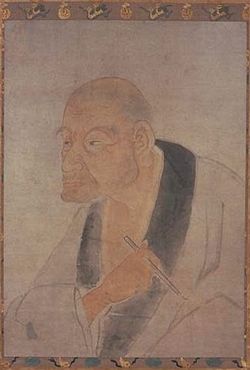
Kano Tanyu
Encyclopedia


Kano school
The ' is one of the most famous schools of Japanese painting. The Kanō school of painting was the dominant style of painting until the Meiji period.It was founded by Kanō Masanobu , a contemporary of Sesshū and student of Shūbun...
. His original given name was Morinobu; he was the eldest son of Kanō Takanobu and grandson of Kanō Eitoku
Kano Eitoku
was a Japanese painter who lived during the Azuchi–Momoyama period of Japanese history and one of the most prominent patriarchs of the Kanō school of Japanese painting...
. Many of the most famous and widely known Kanō works today are by Tan'yū.
In 1617, Tan'yū was appointed by the Tokugawa shogunate
Tokugawa shogunate
The Tokugawa shogunate, also known as the and the , was a feudal regime of Japan established by Tokugawa Ieyasu and ruled by the shoguns of the Tokugawa family. This period is known as the Edo period and gets its name from the capital city, Edo, which is now called Tokyo, after the name was...
to become one of the shogunate's official artists. Over the following years, he was given many highly prestigious commissions. Over the 1620s and '30s, he created a number of large-scale works for Edo Castle
Edo Castle
, also known as , is a flatland castle that was built in 1457 by Ōta Dōkan. It is located in Chiyoda in Tokyo, then known as Edo, Toshima District, Musashi Province. Tokugawa Ieyasu established the Tokugawa shogunate here. It was the residence of the shogun and location of the shogunate, and also...
, Nijō Castle
Nijo Castle
is a flatland castle located in Kyoto, Japan. The castle consists of two concentric rings of fortifications, the Ninomaru Palace, the ruins of the Honmaru Palace, various support buildings and several gardens...
, Osaka Castle
Osaka Castle
is a Japanese castle in Chūō-ku, Osaka, Japan.Originally called Ozakajō, it is one of Japan's most famous castles, and played a major role in the unification of Japan during the sixteenth century of the Azuchi-Momoyama period.-Description:...
, Nagoya Castle
Nagoya Castle
is a Japanese castle located in Nagoya, central Japan. During the Edo period, Nagoya Castle was the center of one of the most important castle towns in Japan—Nagoya-juku— and it included the most important stops along the Minoji, which linked the Tōkaidō with the Nakasendō.-History:In...
, and Nikkō Tōshō-gū
Nikko Tosho-gu
is a Shinto shrine located in Nikkō, Tochigi Prefecture, Japan. It is part of the "Shrines and Temples of Nikkō", a UNESCO World Heritage Site.Tōshō-gū is dedicated to Tokugawa Ieyasu, the founder of the Tokugawa shogunate. Initially built in 1617, during the Edo period, while Ieyasu's son Hidetada...
.
Prolific in a variety of painting styles, Tan'yū's most famous works are probably those he produced for these large-scale commissions. They are screens and panels, prime examples of the Momoyama style, depicting natural subjects such as tigers, birds and plants, in bright colors and with extensive use of gold leaf. The gold, often used to represent clouds, water, or other background elements, would reflect what little light was available indoors, brightening a castle's dark rooms.
Tan'yū was also accomplished, however, in monochrome ink painting
Ink and wash painting
Ink and wash painting is an East Asian type of brush painting also known as ink wash painting. Only black ink — the same as used in East Asian calligraphy — is used, in various concentrations....
based on the prototypical style of the Muromachi period
Muromachi period
The is a division of Japanese history running from approximately 1336 to 1573. The period marks the governance of the Muromachi or Ashikaga shogunate, which was officially established in 1338 by the first Muromachi shogun, Ashikaga Takauji, two years after the brief Kemmu restoration of imperial...
, yamato-e
Yamato-e
Yamato-e is a style of Japanese painting inspired by Tang Dynasty paintings and developed in the late Heian period. It is considered the classical Japanese style...
compositions in a style similar to that of the Tosa school
Tosa school
The Tosa school of Japanese painting was founded in the 15th century, and was devoted to yamato-e, which are paintings specializing in subject matter and techniques derived from ancient Japanese art, as opposed to schools influenced by Chinese art....
, and Chinese style scrolls. His most famous yamato-e work is a narrative handscroll depicting the life of Tokugawa Ieyasu
Tokugawa Ieyasu
was the founder and first shogun of the Tokugawa shogunate of Japan , which ruled from the Battle of Sekigahara in 1600 until the Meiji Restoration in 1868. Ieyasu seized power in 1600, received appointment as shogun in 1603, abdicated from office in 1605, but...
, the first Tokugawa shogun and major figure in Japanese history. It was after this commission, in 1640, that the artist first took on the "artist name" of Tan'yū.
In addition to being a highly honored and respected painter in his own right, Tan'yū was known as a collector and connoisseur of Chinese paintings. He made sketches and kept records of many of the paintings that passed through his studio, brought to him for authentication.

